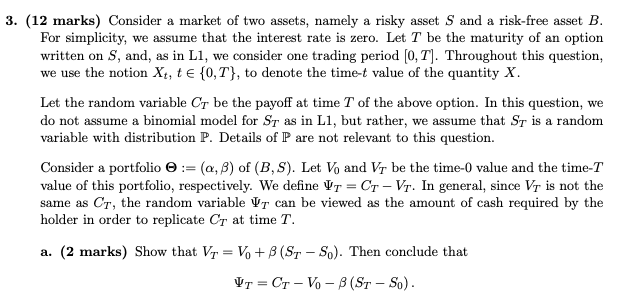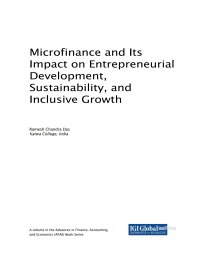

3. (12 marks) Consider a market of two assets, namely a risky asset S and a risk-free asset B. For simplicity, we assume that the interest rate is zero. Let T be the maturity of an option written on S, and, as in L1, we consider one trading period (0,T]. Throughout this question, we use the notion Xt, te {0,T}, to denote the time-t value of the quantity X. Let the random variable Cr be the payoff at time T of the above option. In this question, we do not assume a binomial model for Sr as in Li, but rather, we assume that St is a random variable with distribution P. Details of P are not relevant to this question. Consider a portfolio := (2,8) of (B,S). Let V, and Vj be the time-0 value and the time-T value of this portfolio, respectively. We define VT = Cr-Vr. In general, since Vr is not the same as Cr, the random variable Vy can be viewed as the amount of cash required by the holder in order to replicate Cr at time T. a. (2 marks) Show that Vr = V0 +3 (St-S.). Then conclude that UT = Cr-V-B (St - So). b. (5 marks) Find expressions for V, and 8 in terms of the E (ST), E (Cr), Var(Sr), and Cov(St, CT) that minimize E[v] Here, E (-), Var(-), and Cov ,-) respectively denote the expectation, variance, and covari- ance operators. 3. (12 marks) Consider a market of two assets, namely a risky asset S and a risk-free asset B. For simplicity, we assume that the interest rate is zero. Let T be the maturity of an option written on S, and, as in L1, we consider one trading period (0,T]. Throughout this question, we use the notion Xt, te {0,T}, to denote the time-t value of the quantity X. Let the random variable Cr be the payoff at time T of the above option. In this question, we do not assume a binomial model for Sr as in Li, but rather, we assume that St is a random variable with distribution P. Details of P are not relevant to this question. Consider a portfolio := (2,8) of (B,S). Let V, and Vj be the time-0 value and the time-T value of this portfolio, respectively. We define VT = Cr-Vr. In general, since Vr is not the same as Cr, the random variable Vy can be viewed as the amount of cash required by the holder in order to replicate Cr at time T. a. (2 marks) Show that Vr = V0 +3 (St-S.). Then conclude that UT = Cr-V-B (St - So). b. (5 marks) Find expressions for V, and 8 in terms of the E (ST), E (Cr), Var(Sr), and Cov(St, CT) that minimize E[v] Here, E (-), Var(-), and Cov ,-) respectively denote the expectation, variance, and covari- ance operators








